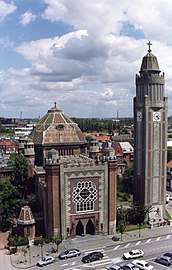Chrysolius
Saint Chrysolius (French: Chrysole, Chryseuil) the Armenian is the patron saint of Komen/Comines, today in Belgium and France;[1] his relics were venerated in the basilica of St Donatian, Bruges.[2] According to tradition, he was a native of Armenia who fled to Rome during the persecution of Christians by Diocletian, was received by Pope Marcellus I and sent to northeast Gaul, where he evangelized at Verlengehem.[3] According to his legend, he then became a spiritual student of Saint Denis and was sent with Saint Piatus to evangelize the area of Cambrai and Tournai.[4] Chrysolius then became a bishop[5] and was subsequently stopped by Roman soldiers and condemned to be decapitated; the top of his skull was sliced off.[4] According to his legend, the piece of his skull broke into three smaller pieces, and where each piece fell, a miraculous spring gushed out.[4] Chrysolius, after recovering the top of his cranium, walked to Komen and died there, after crossing the ford at the Deule River that now bears his name.[4]
Saint Chrysolius | |
|---|---|
| Martyr | |
| Born | Armenia |
| Died | ~300 AD Belgium |
| Venerated in | Roman Catholic Church |
| Feast | 7 February |
| Patronage | Komen |
Veneration
The waters of the springs where pieces of his head are said to have fallen were believed to cure ailments of the throat and eyes.[4]
The rosette in the façade of the church of Saint-Vaast at Wambrechies depicts Chrysolius, along with saints Hubert, Benedict, and Bernard.[4]
The church of Saint-Chrysole was rebuilt in neo-Byzantine style between 1922–1929, after its predecessor was destroyed in World War I.
 Church of St.-Chrysole, Komen
Church of St.-Chrysole, Komen Construction of the church of St.-Chrysole, Komen
Construction of the church of St.-Chrysole, Komen Church of St.-Chrysole, Komen
Church of St.-Chrysole, Komen
References
- William Smith and Henry Wace, A Dictionary of Christian Biography, Literature, Sects and Doctrines, 1877, vol. I s.v. "Chrysolius"
- St. Chrysolius.
- ; Smith and Wace.
- Casteleyn, Maryse. (February 9, 2008). "Saint Chrysole a donné son nom à plus d'un lieu à Wambrechies". La Voix du Nord. Retrieved September 22, 2008.
- According to André du Saussay, Martyrologium gallicanum (Paris 1637), noted in Smith and Wace. The historical bishoprics of this region date to the sixth century.